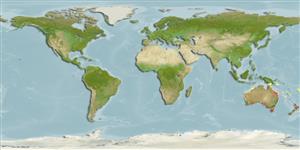Teleostei (teleosts) >
Syngnathiformes (Pipefishes and seahorses) >
Syngnathidae (Pipefishes and seahorses) > Syngnathinae
Etymology: Urocampus: Greek, oura = tail + greek, kampe = curved (Ref. 45335).
More on author: Castelnau.
Environment: milieu / climate zone / depth range / distribution range
Ecology
Marine; brackish; demersal; depth range 0 - 5 m (Ref. 5316). Tropical; 8°S - 45°S
Western Pacific: Australia and Papua New Guinea.
Size / Weight / Age
Maturity: Lm ? range ? - ? cm
Max length : 10.0 cm SL male/unsexed; (Ref. 31838)
Dorsal spines (total): 0; Dorsal soft rays (total): 13 - 15; Anal spines: 0; Anal soft rays: 2. Small and slender, and have a short, thick snout, continuous superior trunk and tail ridges, small pectoral fins, and a dorsal fin that originates on tail rings 5-9. Body usually has numerous hair-like appendages which provide camouflage.
Inhabit lower reaches of rivers, estuaries or other protected inshore habitats (Ref. 5316). Found mostly in algal or Zostera beds (Ref. 5316), rarely at depths of more than a few meters (Ref. 31838). Ovoviviparous (Ref. 205). The male carries the eggs in a brood pouch which is found under the tail (Ref. 205).
Male carries the eggs in a brood pouch (Ref. 205). Up to 20 eggs are incubated by the male in a brood pouch formed from laterally expanded flaps of skin on the underside of the tail. Newly emerged larvae may remain in the pouch (Ref. 31838).
Paxton, J.R., D.F. Hoese, G.R. Allen and J.E. Hanley, 1989. Pisces. Petromyzontidae to Carangidae. Zoological Catalogue of Australia, Vol. 7. Australian Government Publishing Service, Canberra, 665 p. (Ref. 7300)
IUCN Red List Status (Ref. 130435: Version 2024-1)
Threat to humans
Harmless
Human uses
Tools
Special reports
Download XML
Internet sources
Estimates based on models
Preferred temperature (Ref.
123201): 14.6 - 25.5, mean 18.3 °C (based on 410 cells).
Phylogenetic diversity index (Ref.
82804): PD
50 = 0.7500 [Uniqueness, from 0.5 = low to 2.0 = high].
Bayesian length-weight: a=0.00037 (0.00016 - 0.00085), b=3.18 (2.99 - 3.37), in cm total length, based on LWR estimates for this (Sub)family-body shape (Ref.
93245).
Trophic level (Ref.
69278): 3.0 ±0.1 se; based on diet studies.
Resilience (Ref.
120179): Low, minimum population doubling time 4.5 - 14 years (Fec=20).
Fishing Vulnerability (Ref.
59153): Low vulnerability (10 of 100).
